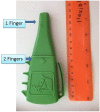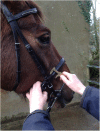Noseband Use in Equestrian Sports - An International Study
- PMID: 28045961
- PMCID: PMC5207535
- DOI: 10.1371/journal.pone.0169060
Noseband Use in Equestrian Sports - An International Study
Abstract
Nosebands are used by riders to prevent the horse from opening its mouth, to increase control and, in some cases, to comply with the competition rules. While equestrian texts traditionally recommend that two adult human fingers should be able to fit under a fastened noseband, noseband tightness levels are not, in general, regulated in competition. Possible detrimental consequences for the horse, of excessively tight nosebands, include discomfort, pain or tissue damage. The current study investigated noseband usage in equestrian competition. Data regarding noseband type, position, width and tightness were collected from 750 horses in eventing (n = 354), dressage (n = 334) and performance hunter (n = 62) competitions in Ireland, England and Belgium. Data were collected immediately before or after the performance. Using the ISES taper gauge as a guide, results were classified according to the number of 'fingers' that could fit under the noseband at the nasal planum, and assigned to six groups: greater than 2 fingers; 2 fingers; 1.5 fingers; 1 finger; 0.5 fingers; zero fingers. A calliper was used to measure noseband width and position relative to the facial crest. The data were not normally distributed so Kruskall-Wallis and Mann-Whitney tests were used. In all, 44% of horses fell into the zero fingers classification while only 7% were in the two fingers classification. Significant differences emerged between disciplines (p<0.001), with the highest levels of noseband tightness measured among eventers followed by dressage horses with lowest levels among performance hunters. Noseband tightness did not differ significantly with horse age (p>0.05), which ranged from 4 to 19 years. The flash noseband was the most commonly used noseband (n = 326) and was significantly tighter than the cavesson (p < 0.001), drop noseband (p < 0.001) and the Micklem (p < 0.005). Noseband width ranged from 10 to 50 mm. Noseband position varied widely with the distance between the facial crest and upper noseband margin ranging from 0 to 70 mm. The high proportion of very tight nosebands found in this study raises concerns regarding the short and long term behavioural and physiological consequences of such tight nosebands are for the horse. Although these data are currently lacking, the findings are of concern.
Conflict of interest statement
The authors have declared that no competing interests exist.
Figures











References
-
- McGreevy P, McLean A. Equitation Science. Wiley-Blackwell;2010.
-
- McGreevy P, Warren-Smith A, Guisard Y. The effect of double bridles and jaw-clamping crank nosebands on temperature of eyes and facial skin of horses. Journal of Veterinary Behavior: Clinical Applications and Research. 2012;7:142–148.
-
- Casey V, McGreevy P, O' Muiris E, Doherty O. A preliminary report on estimating the pressures exerted by a crank noseband in the horse. Journal of Veterinary Behaviour, Clinical Applications and Research. 2013;8:479–484.
-
- Anon. Horsemanship for the Pony Club. The British Horse Society; London, UK;1956.
-
- Stecken F. A book of dressage: training the horse and rider. Arco Publishing Company Inc., New York, NY;1977.
MeSH terms
LinkOut - more resources
Full Text Sources
Other Literature Sources

